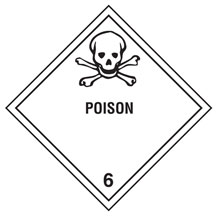



Find all of your laboratory and workplace safety supplies at Safety Emporium!
 LC50 |
 Glossary Index |
 LD50 |
| MSDS Topics |
Free Sites | FAQ's | Regulations | Glossary | Software | Suppliers |
| Books | Forum | Poll | Fun stuff | Quiz | Store | |
| Understand your MSDS with the MS-Demystifier | Search ALL our MSDS info | |||||

Be sure you're in compliance with DOT placards and labels from Safety Emporium.
An LCLo value is the lowest concentration of a material in air reported to have caused the death of animals or humans. The exposure may be acute or chronic. This is also called the lowest concentration causing death, lowest detected lethal concentration, and lethal concentration low.
LCLo is closely related to the LC50 value which is the concentration which kills half of the test animals under controlled conditions.
This value applies to vapors, dusts, mists and gases. Solids and liquids use the closely related LDLo value for routes other than inhalation.
Both LC50 and LD50 values state the animal used in the test. This is important because animal toxicity studies do not necessarily extrapolate (extend) to humans. For example, dioxins (of Love Canal, Times Beach, Sveso and Agent Orange fame) are highly toxic to guinea pigs and ducklings at extremely low levels, but have never been conclusively linked to a single human death even at very high levels of acute (short term) exposure. However, it is best to err on the safe side when evaluating animal toxicity studies and assume that most chemicals that are toxic to animals are toxic to humans.
Typical units for LCLo values are parts per million (ppm) of material in air, micrograms (10-6 = 0.000001 g) per liter of air and milligrams (10-3 = 0.001 g) per cubic meter of air (see volume units and mass units).
LC50 and LD50 values, if known, will be found on Section 11 (toxicological information) of a material's Safety Data Sheet. However, the Hazard Communication Standard does not require any testing when an SDS is created, so just because this data is missing or "not known" does not mean that the material is "safe". If no toxicity information is available, treat the material as potentially hazardous!
Never be exposed to an LCLo dose of a hazardous chemical -- by definition, there is a resonable chance of dying!
Of greater practical use than LC50 and LD50 is the OSHA permissible exposure level (PEL) (if the material has one). This is a more realistic determination of the maximum safe exposure to a material and is usually based on the known effects of the chemical on humans rather than laboratory animals.
See also: LD50, mus (mouse), PEL, STEL, TLV.